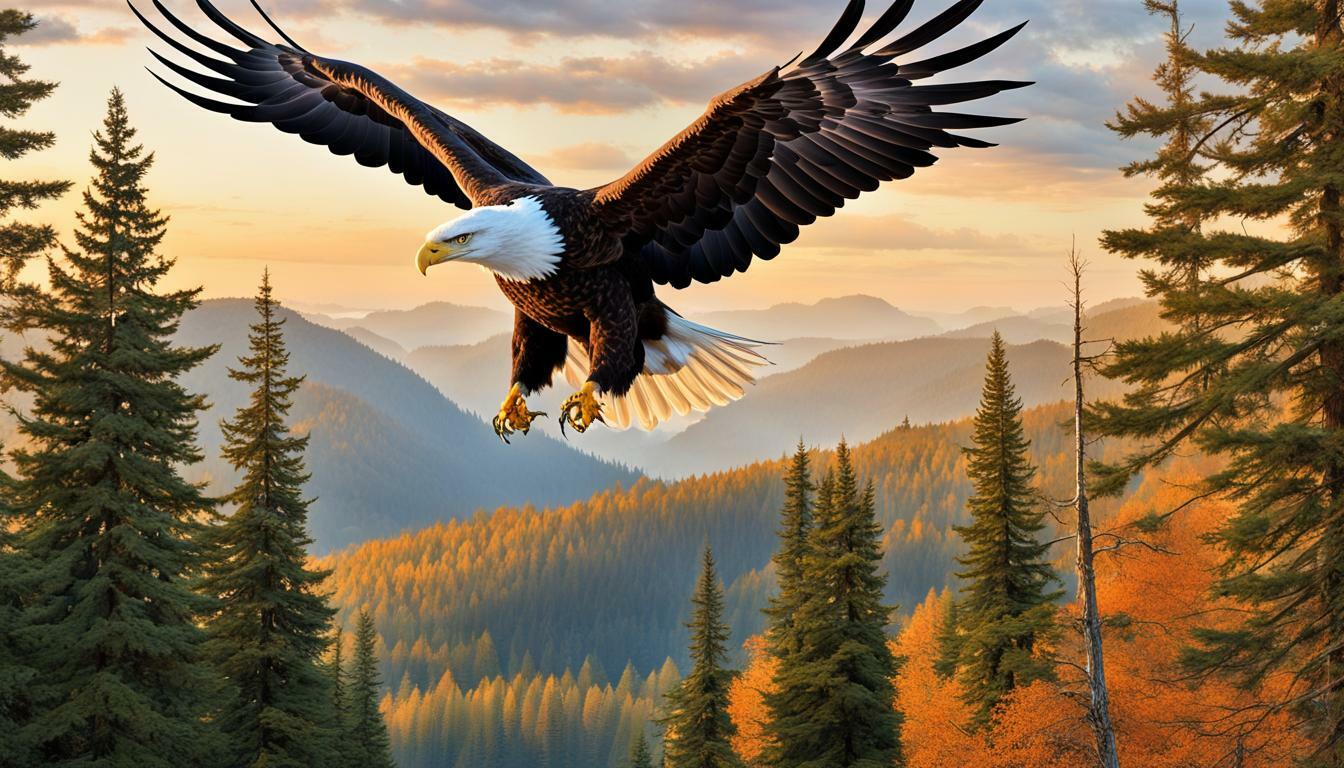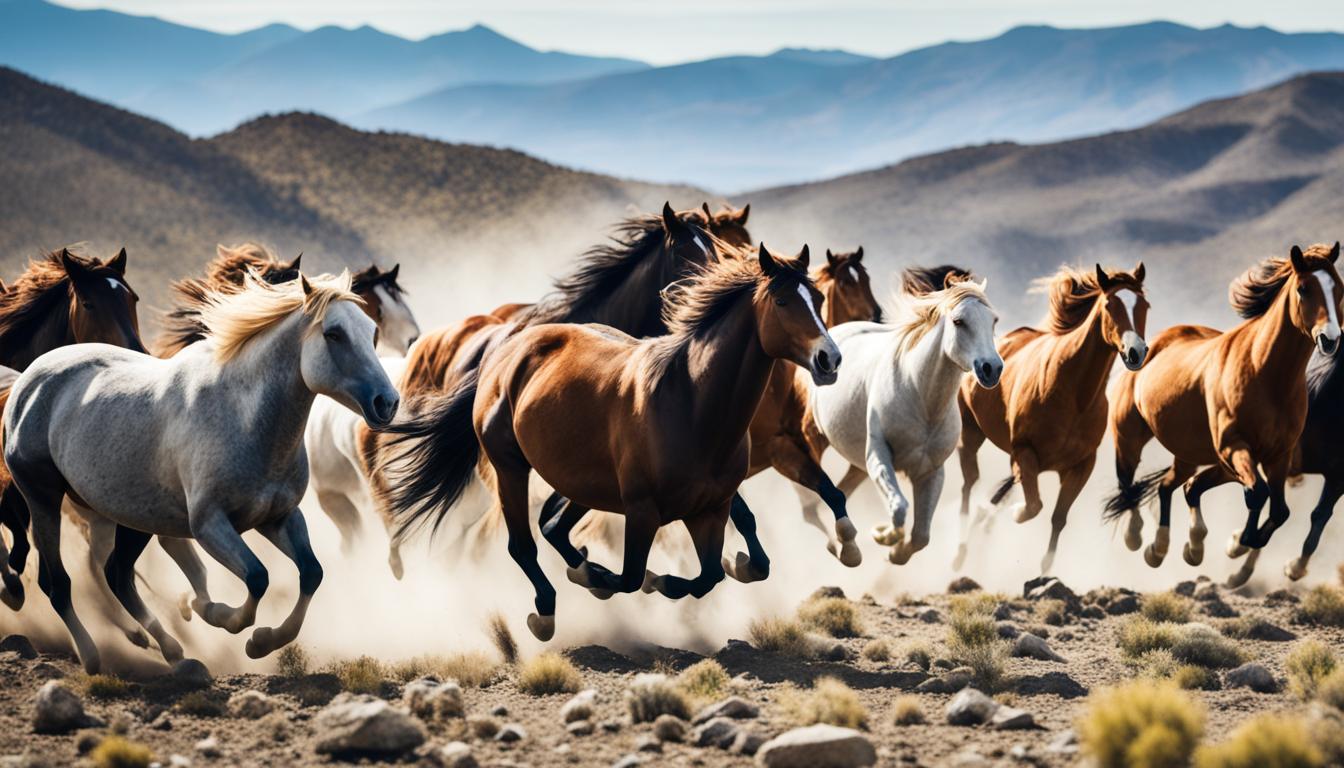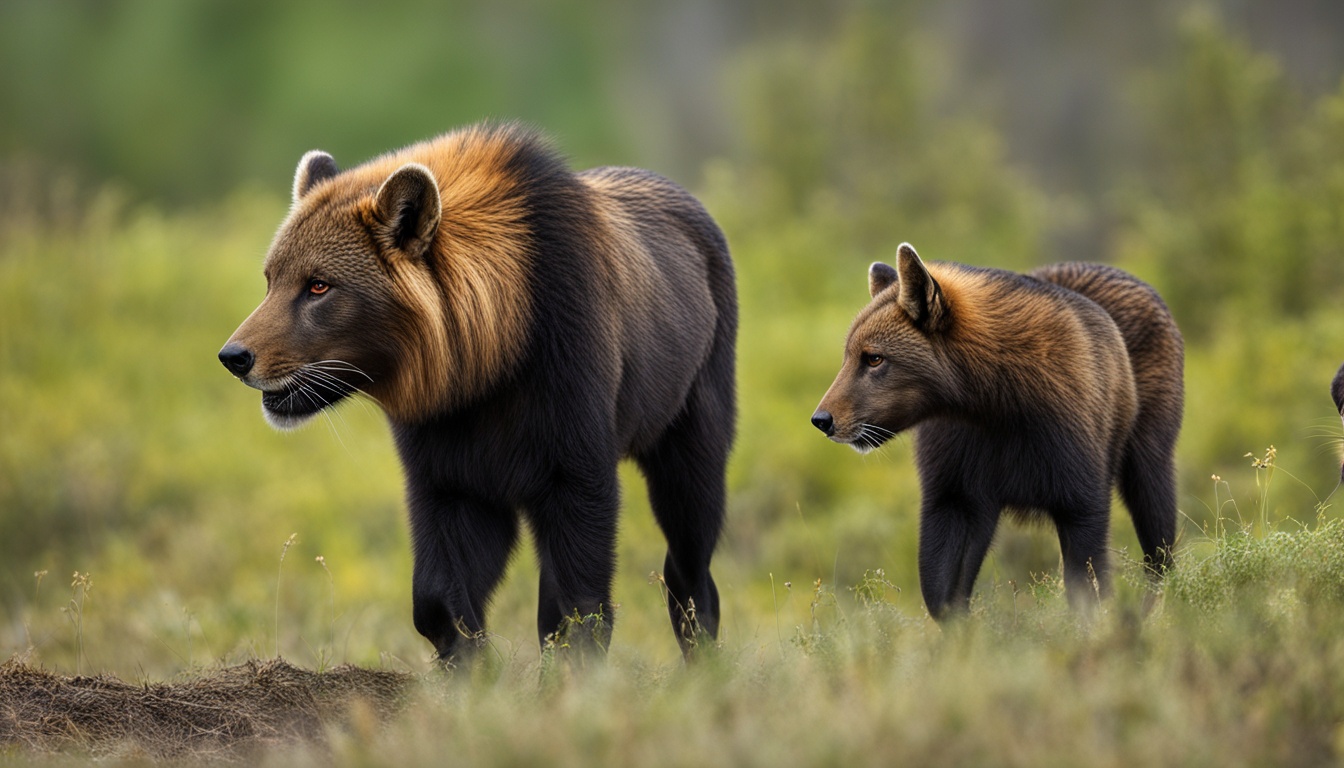Key Takeaways:
- Bald eagles are skilled hunters and primarily feed on fish and small mammals.
- While rare, bald eagles have been known to attack and kill deer, especially fawns.
- We’ll explore bald eagles’ hunting techniques, their ability to consume large prey, and the ecological significance of their predation.
- We’ll also compare bald eagles’ hunting habits to other predators that hunt deer.
Understanding Bald Eagle Predation
If you’re wondering whether bald eagles can kill deer, it’s important to first understand their predation behavior. As apex predators, bald eagles are skilled hunters with a preference for live prey. While they’re best known for feeding on fish, they have a diverse diet that includes small mammals, birds, and reptiles.
When hunting, bald eagles use a combination of soaring, perching, and diving techniques to catch their prey. They have keen eyesight and can spot potential prey from a distance, often soaring high in the sky to gain a better view of the landscape.
Once a potential target has been spotted, bald eagles will typically swoop down and grab their prey with their powerful talons. They can also hunt on the ground, using their sharp beak to kill or injure their prey before carrying it away.
Factors Influencing Bald Eagle Prey Selection
With such a diverse diet, it’s interesting to consider what factors influence bald eagle prey selection. Generally, they prefer prey that is easy to catch and provides a high level of nutrition. For example, bald eagles may target sick or injured animals, as well as juvenile or smaller-sized prey that are easier to subdue.
Other factors that may influence bald eagle prey selection include habitat availability and competition from other predators. For example, if food sources are scarce in a particular area, bald eagles may be more likely to target larger prey such as deer.
Overall, while bald eagles do have the ability to kill deer, it’s not their primary food source. They typically prefer smaller, more easily captured prey, although they may occasionally target larger animals if circumstances are favorable.
Bald Eagle Feeding Behavior
Bald eagles are known for their powerful hunting skills and preference for fish. However, they are opportunistic feeders that can consume a wide variety of prey, including mammals such as rabbits and squirrels, and even other birds.
Despite their impressive size (with wingspans reaching up to 7 feet), bald eagles have been observed carrying prey that exceeds their own weight. They use their strong talons to grab onto their prey and then use their powerful beaks to tear meat off the carcass.
In rare instances, bald eagles have been documented preying on deer. However, these occurrences are few and far between, as bald eagles typically prefer smaller prey that is easier to catch and carry.
| Bald Eagle Feeding Behavior: | |
|---|---|
| Prey: | Wide variety, including fish, rabbits, squirrels, and small birds |
| Prey Size: | Can exceed their own weight |
| Feeding Method: | Use talons to grab prey, then use beak to tear meat off carcass |
| Prey Preference: | Smaller prey that is easier to catch and carry |
Overall, while bald eagles are capable of preying on deer, they are unlikely to do so unless other food sources are scarce. Their feeding behavior is largely influenced by availability, habitat, and competition.
Bald Eagle vs. Deer: Size and Strength Comparison
Bald eagles are known for their impressive size, with adults typically weighing between 8 and 14 pounds and having a wingspan of up to 7 feet. While this might seem massive in comparison to other birds, it is still significantly smaller than the average deer.
White-tailed deer, the most common deer species in North America, can weigh anywhere from 100 to 300 pounds, with males being larger than females. They also have powerful legs and hooves that can deliver a deadly kick.
Despite the bald eagle’s size disadvantage, they have certain advantages over deer. For example, they have sharp talons that can easily grasp onto their prey, and they are exceptionally fast and agile fliers, allowing them to sneak up on unsuspecting animals.
“While bald eagles are not typically known for preying on deer, they have been known to take down smaller animals such as rabbits, fish, and even other birds.”
It is important to note that a bald eagle’s ability to prey on a deer largely depends on the size and health of the deer, as well as the eagle’s hunting technique and strategy.
Bald Eagle Hunting Techniques
When it comes to hunting prey, bald eagles are skilled and formidable hunters. They use a variety of techniques to catch their food, with their aerial prowess being one of their most impressive features.
One of the ways bald eagles hunt is by spotting prey from high up in the air and then diving down to catch it. They can reach speeds of up to 100 miles per hour during these steep, rapid dives, which are known as stoops. Bald eagles are also known to use their sharp talons to grab and kill smaller prey, such as fish and rodents.
In addition to hunting from the air, bald eagles also hunt from the ground. They will often snatch up prey that is already dead or injured, making them opportunistic hunters. Bald eagles have even been known to steal prey from other predators, such as ospreys, foxes, and coyotes.
Despite their impressive hunting skills, bald eagles do have some limitations. Their preferred prey tend to be smaller animals, such as fish and small mammals. While they are capable of taking down larger prey, such as deer, it is a rare occurrence that requires specific circumstances.
The bald eagle’s hunting techniques showcase its impressive aerial abilities as well as its opportunistic and adaptable nature.
Rare Instances of Bald Eagles Preying on Deer
Bald eagles are known for their predatory behavior, particularly their ability to hunt fish and small mammals. While they are not typically considered a threat to deer, there have been documented instances of bald eagles preying on these larger mammals.
One such instance occurred in Alaska, where researchers observed a bald eagle attacking and killing a young Sitka black-tailed deer. This was the first documented case of a bald eagle preying on deer in this region.
Another case involved an adult bald eagle attacking and killing a white-tailed deer fawn in Pennsylvania. The eagle was later found feeding on the carcass, which provided evidence of its involvement in the fawn’s death.
Despite these rare occurrences, it’s important to note that bald eagles still primarily rely on fish and other small prey for their survival. Their hunting habits are based on availability and preference, so they may only target deer when other food sources are scarce.
Overall, while bald eagles are not typically considered a threat to deer, these rare instances of predation highlight the versatility and adaptability of these impressive birds of prey.
Factors Influencing Bald Eagle Prey Selection
When it comes to prey selection, bald eagles are opportunistic hunters, meaning they will eat whatever is available and easy to catch. However, certain factors can influence their food preferences and hunting habits.
Availability of Prey: Bald eagles primarily feed on fish, but they will also hunt small mammals, birds, and reptiles if they’re available in the area. If a bald eagle’s preferred prey is scarce or unavailable, it will look for alternative food sources.
Habitat: Bald eagles are commonly found near bodies of water, as it’s the primary source of their prey. They will hunt near rivers, lakes, and other bodies of water that have fish populations. In areas where there are no water sources, bald eagles may hunt for small mammals or birds that live in trees.
Competition: Bald eagles will adapt their hunting habits based on the competition in the area. For example, if other predators are hunting in the same area, the bald eagles may alter their food preferences or hunt in a different location. This also applies to other bald eagles, as they may compete for food sources.
Overall, bald eagles are versatile hunters that can eat a wide variety of prey. However, their food preferences and hunting habits are influenced by factors such as availability, habitat, and competition.
Ecological Significance of Bald Eagle Predation
While it may be rare for bald eagles to prey on deer, their role as predators serves an important ecological function. As apex predators, bald eagles help to regulate populations of other species in their food chain, such as fish and small mammals.
In addition, bald eagle predation can affect the behavior and movement patterns of their prey. This can have a ripple effect throughout the ecosystem, influencing the distribution of other species and the overall community structure.
Furthermore, the presence of bald eagles in an area can serve as an indicator of a healthy ecosystem. Their dependence on a wide variety of prey species suggests that the environment is able to support a diverse range of organisms.
Other Predators of Deer
While bald eagles are known to prey on deer, they are not the only predators to do so. Other predators of deer include coyotes, wolves, bobcats, and mountain lions. Each of these predators has its hunting habits and strategies.
Coyotes are opportunistic predators and will take prey of any size. They often work in packs to take down larger animals such as deer. Wolves are also known to hunt in packs and can take down even the largest deer with their coordinated effort.
Bobcats are solitary hunters and prefer smaller prey, but they have been known to take down deer on occasion. Mountain lions, also known as cougars, are skilled and elusive hunters that can take down large prey such as deer.
Compared to these predators, bald eagles have a unique hunting style. They rely on their aerial prowess and hunting strategies to catch their prey, whereas other predators typically ambush or chase their prey on the ground.
Overall, while bald eagles are capable of preying on deer, they are not the only predators to do so. The different hunting habits and strategies of these predators contribute to the natural balance and ecosystem health.
Conclusion
Congratulations, you have now discovered the truth behind the question “Can bald eagles kill deer?” It turns out that while bald eagles are known to hunt and consume a wide variety of prey, including fish, small mammals, and birds, there are only rare instances in which they have been documented preying on deer. Through our exploration of bald eagle predation behavior, feeding habits, hunting techniques, and ecological significance, we have gained a greater understanding of how these majestic birds fit into the natural balance of their ecosystems. It is important to note that while bald eagles are known to hunt prey of varying sizes and strengths, they are just one of many predators that deer may encounter. Other predators, including wolves, coyotes, and mountain lions, also play vital roles in maintaining healthy and diverse ecosystems. Overall, while you may not see a bald eagle swooping down to catch a deer anytime soon, their unique hunting abilities and importance to their ecosystems make them a truly fascinating species to learn about and admire.Are Deer Protected by Eagle Protection Laws?
Understanding bald eagle protection laws is crucial when considering whether deer are protected by them. While these laws primarily focus on safeguarding bald eagles, they do not directly extend to protecting other animals such as deer. However, environmental regulations may indirectly impact deer populations, as protecting habitats and ecosystems benefits all wildlife.
FAQ
Q: Can bald eagles kill deer?
A: Bald eagles are primarily fish-eating birds and do not typically hunt large mammals like deer. While they have the strength to lift small prey, such as fish or smaller birds, it is highly unlikely for a bald eagle to kill a deer.
Q: What are the hunting habits of bald eagles?
A: Bald eagles primarily hunt for fish, but they are opportunistic predators and will also prey on small mammals, waterfowl, and carrion. They use their sharp talons and powerful beaks to catch and kill their prey.
Q: Do bald eagles feed on deer?
A: While it is unusual, there have been some documented instances of bald eagles feeding on deer carrion. However, these occurrences are rare and not a common part of their diet.
Q: How do bald eagles compare to deer in terms of size and strength?
A: Bald eagles are larger and more powerful than deer. An adult bald eagle can have a wingspan of up to 7 feet and weigh around 10 to 14 pounds, while deer typically weigh several hundred pounds.
Q: What hunting techniques do bald eagles use?
A: Bald eagles are skilled hunters and use a variety of techniques. They often soar high in the sky and spot their prey from a distance before swooping down to catch it with their talons. They can also perform shallow dives into the water to catch fish.
Q: Are there any known instances of bald eagles preying on deer?
A: There have been some documented instances of bald eagles feeding on deer carrion or scavenging from deer carcasses, but direct predation on live deer is extremely rare.
Q: What factors influence bald eagle prey selection?
A: Bald eagles select their prey based on availability, habitat, and competition. They are opportunistic hunters and will target whatever food source is readily accessible.
Q: What is the ecological significance of bald eagle predation?
A: Bald eagle predation plays a crucial role in maintaining the natural balance of ecosystems. By controlling populations of prey species, including fish and small mammals, they help to regulate the overall health of the ecosystem.
Q: Are there other predators of deer aside from bald eagles?
A: Yes, there are several other predators known to hunt deer, including wolves, coyotes, cougars, and bears. These predators have different hunting habits and strategies compared to bald eagles.
Q: Can bald eagles kill deer?
A: Based on their natural hunting habits and available evidence, it is highly unlikely for bald eagles to kill deer. While they may scavenge or feed on deer carrion, direct predation on live deer is not a common behavior for bald eagles.











